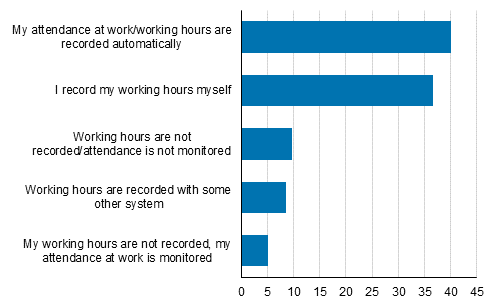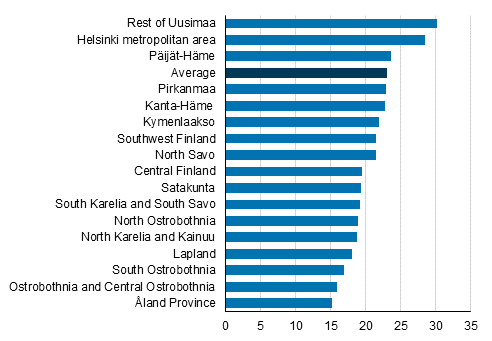Published: 31 August 2020
Recording of working hours is commonly made by employees themselves
An additional survey for the Labour Force Survey studied the organisation of gainful work, working time arrangements and duration of commuting during 2019. The results show that 90 per cent of employees are covered by recording of working hours or monitoring of attendance at work. Very few consider their home to be their primary workplace. The journey to work takes longest time in Uusimaa.
Around ten per cent of employees do not have recording of working hours or monitoring of attendance at work at all. Of them the share of male employees is 53 per cent and that of female employees 47 per cent. Approximately 10 per cent of employees evenly in all employer sectors are outside the monitoring of working hours.
Attendance and working hours are most commonly monitored by means of remote identifiers, computers or other similar devices in which 40 per cent of employees say they are included. It is often a question of making a working time recording on a flexitime control equipment when coming to work.
It is surprisingly common for employees to record working hours themselves manually, as 37 per cent of employees say they use this method. Working hours are also recorded to some extent by other means, or they are not recorded, but attendance is monitored anyway.
Monitoring of working hours and attendance in 2019, share of employees

Employer's premises the primary place of work
Over three-quarters (77%) of employees mainly work in their employer's premises. In all, four per cent of employees regard their home as their workplace and 11 per cent the customer's premises.
A majority (56%) of employees stay at their main place of work but a considerable share (44%) work at least monthly elsewhere as well. Ten per cent of all employees also work daily outside their main place of work.
Time used for commuting varies by region
Commuting is longest for upper-level employees, but the difference is not big compared to employees on average. For 25 per cent of upper-level employees, commuting takes over 30 minutes, while the corresponding share for all employees is 21 per cent. For 26 per cent of employees, commuting takes 10 minutes or less and for 58 per cent at most 20 minutes.
The time used for commuting is clearly longer in Helsinki metropolitan area and Uusimaa than elsewhere in the country. The average length of commuting in one direction in Uusimaa is 30 minutes, while the average length of commuting in the whole country is 23 minutes. The longest commuting is centred on the satellite areas of Uusimaa, the shortest in the regions of Åland and Ostrobothnia.
Average length of one-way commuting in minutes by region in 2019

Survey results from 2019, effects of corona are not visible
In 2019, data on the organisation of work and working time arrangements at workplaces were examined in the ad hoc module of the Labour Force Survey. The responses are personal views of those having participated in the survey. The data concern the main jobs of employed persons.
Around 11,200 persons of different age groups, regions and genders answered the inquiry. The results have been generalised to apply to employed persons aged 15 to 74 permanently resident in Finland in 2019. The survey is financed by the EU.
It should be noted that the corona epidemic in 2020 has affected the organisation and places of work and therefore the results cannot be considered to concern the exceptional circumstances in 2020.
Links
Quality description (Labour Force Survey), AHM collections
Eurostat, the Statistical Office of the European Union, publishes/has published results by country
This release is supplemented in the article Työaikojen järjestely on selvästi helpompaa miehille kuin naisille – erot ovat monen tekijän summa (in Finnish only) Tieto&Trendit Artikkelit
Source: Labour Force Survey 2019. Statistics Finland
Inquiries: Pertti Taskinen 029 551 2690, Jere Immonen 029 551 3261, tyovoimatutkimus@stat.fi
Director in charge: Jari Tarkoma
Publication in pdf-format (297.9 kB)
- Tables
-
Tables in databases
Pick the data you need into tables, view the data as graphs, or download the data for your use.
- Quality descriptions
-
- Quality Description: Labour force survey (31.8.2020)
Updated 31.8.2020
Official Statistics of Finland (OSF):
Labour force survey [e-publication].
ISSN=1798-7857. Working time arrangements 2019. Helsinki: Statistics Finland [referred: 29.12.2025].
Access method: http://stat.fi/til/tyti/2019/17/tyti_2019_17_2020-08-31_tie_001_en.html

